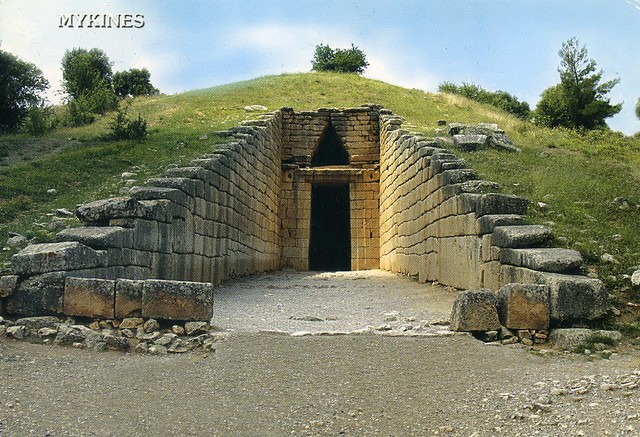I don't have too many Unesco postcards from Greece... Well, here's one! It's part of the Archaeological Sites of Mycenae and Tiryns.
Mycenae and Tiryns represent the apogee of the Mycenaean civilization, which laid the foundations for the evolution of later European cultures, including classical Greek architecture and urban design, and consequently also on contemporary cultural forms. Moreover, the two sites are indissolubly linked with the Homeric epics, the Iliad and the Odyssey, the influence of which upon European literature and the arts has been profound for more than three millennia.
The Mycenaean civilization developed on the Greek mainland in the late Bronze Age (16th century BC). It was essentially a continuation of the Middle Helladic culture, transformed by Minoan influences from Crete. Knowledge of its two earlier periods I (c . 1580-1500 BC) and II (c . 1500-1400 BC) comes mainly from burials, notably the shaft graves at Mycenae. Towards the end of Period II more elaborate tomb types developed - large chamber tombs for families and beehive-shaped (tholos) tombs for royalty. The apogee of the Mycenaean civilization came in Period III (c . 1400-1120 BC), when strong citadels and elaborate palaces were built. Towards the end of this period a script, known as Linear B, came into use; the language used has been shown to be an early form of Greek, confirming that the Mycenaeans were Greek speakers of Indo-European origin. The political structure was that of an autocratic monarchy, the ruler of which was known as the wanax, who administered his territory by means of a hierarchical structure of officials. There was a special class of priests and priestesses. The people were organized in an elaborate class system, and slavery was widely practised.
The site of Mycenae is known from excavations to have been occupied from the Neolithic period (c . 4000 BC). During the Middle Helladic period a cemetery was established on the southern slopes of the natural hill which included Grave Circle B (dated to the 17th century BC) and Grave Circle A (16th century BC). The Palace was constructed on the summit of the hill and surrounded by massive cyclopean walls in three stages (c . 1350, 1250 and 1225 BC respectively). In the final stage the underground reservoir was also fortified. A series of tholos tombs were built on the southern and south-western slopes of the hill during the Mycenaean period: the so-called Tomb of Aegisthos (c. 1500 BC), the Lion Tholos Tomb (c. 1350 BC), the Tomb of Clytemnestra (c. 1220 BC), culminating in the Treasury of Atreus, at some distance from the others. Four large buildings, believed to have been royal workshops, were built in the 13th century BC in the vicinity of Grave Circle B. The palace was abandoned at the end of the 12th century BC and a number of buildings were damaged by fire. However, the site continued to be occupied until 498 BC, when it was conquered by Argos and its inhabitants were expelled. The top of the hill was levelled at this time for the construction of an Archaic temple. The site was reoccupied briefly in the Hellenistic period, when another temple was built and a theatre constructed over the Tomb of Clytemnestra. By the time the Greek traveller Pausanias visited Mycenae in the 2nd century AD it had been completely abandoned for many years.
Subscribe to:
Post Comments (Atom)




 Maroon
Maroon 










































































































































































No comments:
Post a Comment